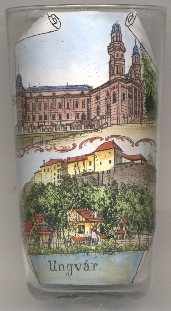

|
| УКРАЇНА UKRAJINA | UKRAINE |
| Закарпатська область Zakarpats'ka oblast' | Transcarpathia province |
| Ужгородський район Užhorods'kyj rajon | Užhorod district |
Ужгород (Užhorod) (in Ruthenian dialect: Уґоград / Ugohrad) is sitauted at an elevation of 137 m on the river Уж (Už; Hungarian: Ung) in western Ukraine, at the border with Slovakia and near the border to Hungary. It is the administrative centre of the Zakarpats'ka oblast' (region), as well as the Užhorod raion (district) within the oblast. The municipality has a population of about 115,400 (2022).
The earliest known settlers of the earea were early Slavs. One of their tribes, White Croats, settled thise area in the 2nd half of the first
millennium AD. Magyars, who had arrived from the region of Kyiv, stormed the local Ung fortress (Hungarian: Ungvár) in 895 AD.
In 1241/1242 the Mongols burnt the settlement. In 1248 the settlement was granted town rights and after 1430 it obtained the status of a Royal Hungarian
town. During the 16th and 17th centuries there were many handicraft corporations in Uzhhorod. In this period the city was engaged in the religious fight
between primarily Protestant Transylvania and Catholic Austria. In 1646, the Union of Ungvár was proclaimed, whereby the Ruthenian Orthodox
church of the eparchy of Mukačevo (then divided between the Principality of Transylvania and Royal Hungary of the Habsburg
monarchy) joined the Catholic Church (but retianined the Orthodox rite). The beginning of the 19th century was characterized by economic changes, including
the first factories in the city. In 1872 the first railway line opened, linking the city to the important railway junction of Csap (today Чоп
(Čop)). According to the 1910 census, the city had 16,919 inhabitants, of which 80% were Magyars, 7% Slovaks, 7% Germans,
4% Rusyns and 2% Czechs. Since Jews were not counted as ethnicity (as defined by language), rather only as a religious group, this
 census did not specifically mention the Jewish population, which was significant, and represented about 31% of the total population in 1910.
After world War I, the First Vienna Award (1938) handed Užhorod back to Hungary. During Wirld War II, Užhorod was occupied by
German troops in 1944 and the entrire Jewish population was deported to the extermination camp at Auschwitz (Oświeogon;cim). In 1945, 1945,
Subcarpathian Ukraine was annexed by the Soviet Union and became a westernmost part of the Ukrainian SSR. In 1991, Užhorod became one of
24 regional capitals within Ukraine. Of these, Uzhhorod is the smallest and westernmost.
census did not specifically mention the Jewish population, which was significant, and represented about 31% of the total population in 1910.
After world War I, the First Vienna Award (1938) handed Užhorod back to Hungary. During Wirld War II, Užhorod was occupied by
German troops in 1944 and the entrire Jewish population was deported to the extermination camp at Auschwitz (Oświeogon;cim). In 1945, 1945,
Subcarpathian Ukraine was annexed by the Soviet Union and became a westernmost part of the Ukrainian SSR. In 1991, Užhorod became one of
24 regional capitals within Ukraine. Of these, Uzhhorod is the smallest and westernmost.
The Greek-Catholic  cathedral of the Exaltation of the Holy Cross [left, no. 4305: top picture]
is the cathedral and seat of the eparchy Mukačevo in Užhorod. The Baroque church was built in 1646 at the behest
of the Jesuits. After the Society of Jesus was suppressed in 1773, Empress Maria Theresa allowed the Greek Catholics to take possession of the building.
It was renovated in 1848 in Neo-Classical style by the architect László Fabri. During the Soviet period (1945–1991) the building was
transferred to the Russian Orthodox Church. In 1991, after the legalization and restoration of the Greek Catholic Church, the cathedral was returned to
the Greek Catholics.
cathedral of the Exaltation of the Holy Cross [left, no. 4305: top picture]
is the cathedral and seat of the eparchy Mukačevo in Užhorod. The Baroque church was built in 1646 at the behest
of the Jesuits. After the Society of Jesus was suppressed in 1773, Empress Maria Theresa allowed the Greek Catholics to take possession of the building.
It was renovated in 1848 in Neo-Classical style by the architect László Fabri. During the Soviet period (1945–1991) the building was
transferred to the Russian Orthodox Church. In 1991, after the legalization and restoration of the Greek Catholic Church, the cathedral was returned to
the Greek Catholics.
 Užhorod castle [left, no. 4305: bottom picture, background top] is an extensive citadel on a
hill above Užhorod. It was built in a mixture of architectural styles and materials between the 13th and 18th centuries and figured heavily
in the history of Hungary. The earliest stone buildings on the site of the castle may be dated to the 13th century. The fortification, augmented in
the 16th and 17th centuries, underwent numerous sieges but was never taken. In the 18th century, it was modernised. In the early 18th century,
the castle was given over to the Ruthenian Greek-Catholic Church which opened a school there. In 1728 and 1879, fire ravaged the castle grounds.
Užhorod castle [left, no. 4305: bottom picture, background top] is an extensive citadel on a
hill above Užhorod. It was built in a mixture of architectural styles and materials between the 13th and 18th centuries and figured heavily
in the history of Hungary. The earliest stone buildings on the site of the castle may be dated to the 13th century. The fortification, augmented in
the 16th and 17th centuries, underwent numerous sieges but was never taken. In the 18th century, it was modernised. In the early 18th century,
the castle was given over to the Ruthenian Greek-Catholic Church which opened a school there. In 1728 and 1879, fire ravaged the castle grounds.
[https://de.wikipedia.org/wiki/Uschhorod, https://en.wikipedia.org/wiki/Uzhhorod;
https://en.wikipedia.org/wiki/Union_of_Uzhhorod;
https://en.wikipedia.org/wiki/Greek_Catholic_Cathedral,_Uzhhorod;
https://en.wikipedia.org/wiki/Uzhhorod_Castle]
![[scale]](lineal.jpg)